- Chateau de Landiras 2021 Graves Blanc, $26
- Colli di Lapio – Clelia Romano 2018, Aglianico Irpinia ‘Campi Taurasini’, (Organic) $27
- Heimann & Fiai, Blaufrankish Bati Karest Vyrd $30.50
- Barta, Egy Kis Furmint Hungary, $27
- Milos, Plavic Mali 2018 Croatia, $26.50
- Geyerhoff Zweigelt, “Stockwerk”, Demeter cert Kremstal, $27
Not a member? Click to join our “Classic Selections” Wine Club!
———————– (3-bottle Option) ———————–
1. Château de Landiras 2021 Graves Blanc, $26
The Wine
The Winery

Château de Landiras is in the heart of Graves, built on the site of a 12th century fortress. Château de Landiras produces classic Bordeaux of aromatic concentration and elegant structure.
Owner Michel Pélissié developed a keen sense of good food and wine during his formative years in Périgord. A retired architect, Michel now lives his dream of reviving an old estate and making excellent wines. The vineyards are sustainably cultivated (without pesticides or additional chemicals) on the white gravel soils Graves is known for. His outstandingly fresh and vibrant Graves Blanc is vinified in barrique (20%) and temperature-controlled stainless steel tanks (80%).
2. Colli di Lapio – Clelia Romano 2018, Aglianico Irpinia ‘Campi Taurasini’, (Organic) $27
The Wine
That may just be the longest wine name I’ve ever seen! At the shop we shorten it to ‘the Aglianico from Lapio’, and if you ask for that we’ll know what you want. But let’s dive in just a little deeper, as there are some key things you’ll want to know about this wine.
First, the grape – Aglianico (all lee AH nee-ko) – is a red grape known for its deep inky-dark color. The wine it produces is completely opaque and full-bodied. The tannins can be brutal until the wine has spent sufficient time mellowing – you’d be wise to either store this bottle for several years or simply decant it a few hours before serving. But invest the time and you’ll be rewarded with the wine’s intense and persistent aromas of raspberries, dark fruits (plums, hints of bramble fruits) and a pleasant, dusty-earth-and-leather finish.
650 cases produced.
The Winery
This young estate was founded in 1994 by owner-winemaker Clelia Romano and her daughter, Carmela. The windblown slopes of Campania’s mountains host some of the most spectacular vineyards in Italy, planted to varieties that have been cultivated since the time of the ancient Greeks.
Vineyard Management: Colli di Lapio practices organic viticulture, using integrated pest and disease control practices and organic sprays when needed. Fortunately, the breezy and arid climate in this part of Southern Italy’s Campania means that mold and insects are rare. The estate fertilizes with organic manure every two years help build soil health and complexity. Alfalfa is sown between the rows of vines to provide nitrogen to the soil and then tilled in as ‘green manure’ – an organic agriculture term for green compost, essentially. In the cellar, minimal sulfur is added to the wines to ensure freshness and quality throughout their life in bottle.
3. Heimann & Fiai, Blaufrankisch Bati Kareszt Vineyard, Hungary. (Organic) $30.50
The Wine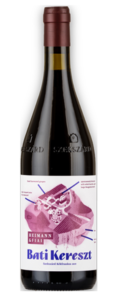
Kékfrankos is the Turkish word for Blaufrankisch, a grape common in Austria that originated in what is now Slovenia. This is a grape of many names, including Lemberger, Blauer Lemberger, Frakovka / Franconia, and Game.
Whatever its name, the wine it produces can be meh or profound, depending on the skill of the producer and the vineyard’s characteristics. At its best, this wine shows a tempting spiciness on top of ample tannins that beg to be paired with foods.
This Kékfrankos shows a characteristic you’ll find in many Hungarian reds – it’s aromatic, spicy, refreshing, and (counterintuitively) has a tannic grip when the fruit-driven aromatic profile led you down the path of carbonic softness. It’s light on the palate without having that puckery, picked-too-early quality.
The Bati Kereszet vineyard faces North and is surrounded by forest, so it is a cool site whose fruit is harvested 2-3 weeks later than its neighbors. Maceration ranges from 5-22 days, pump-overs are light and the eventual pressing is delicate. The finished wine is aged in both tank and barrel for 8 months.
The 2-3 g/l of residual sugar (0.2 – 0.3% – barely detectable) is not felt in the texture (tannins are dry), but rather like the subtle natural sweetness you get from roasted beets or braised red cabbage. Look for notes of red berries, dark chocolate and bramble fruits seasoned with ground peppercorn and sweet pie spices.
“93 pts” James Suckling
“17.5 / 20” Jancis Robinson
The Winery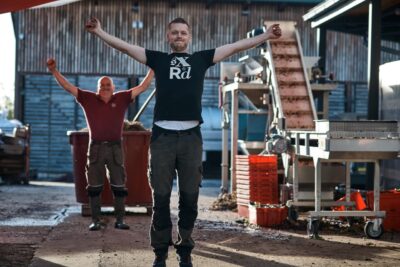
Heimann and Fiai (Heimann and Sons) is found in the Szekszárd (pronunciation? I need to check!) region of Turkey. The family’s stated goal is to “transform Szekszárd into an internationally recognized, high-end wine region capable of appealing to the most sophisticated and curious wine lovers.” And the family could not be more dedicated to this task, not just by producing world-class wines, but by diving into all of the regional marketing boards and committees – five between the three of them (Zoltan and Agnes Heimann, and Zoltan Jr). Junior is now entrenched at the family winery after traveling the world to get an education and experience in winemaking, bringing home lessons and preferences from his experiences.
Today the winery is converting to organic farming and a winemaking style geared towards freshness and aromatics. They achieve this with a variety of techniques – multiple passes to assure perfectly ripe fruit, some whole cluster fermentations, open vat fermentation, less extraction, and gently moving the wine manually instead of through pumps. All fermentation are spontaneous, they use zero fining (so, vegan), and coarsely filter their wine, if at all. A minimal amount of SO2 is deployed at bottling to assure the wine remains unspoiled during its time in the bottle.
———————– (6-bottle Option, all of above, plus…) ———————–
4. Barta, Egy Kis Furmint Hungary, $27
The Wine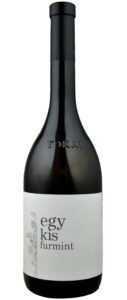
The Winery

Barta with his Winemaker, Vivien Ujvary
A new winery, started in 2013 by Károly Barta, a wealthy Hungarian with a vision for expanding the global profile of wines from the Tokaj region. He bought and famed Öreg Király Dűlő (old king vineyard), restored a 16th century cellar and hired a talented team to execute his vision, granting them full agency and plentiful resources. Does this match our stated goal of discovering and offering wines from passionate family growers and producers? Maybe a little bit not so much. But his passion is undeniable, and just as fervid as the smallest of the boutiques we work with.
As for the vineyard – Öreg Király Dűlő – it’s the highest, steepest, and most distinctly terraced vineyard in all of Tokaj. First mentioned in 1285, there’s written evidence from 1664 that it was farmed by the iconic Rákóczi family, then the rulers of Transylvania. Designated a 1st-class site during Hungary’s 1737 Classification, it was tragically allowed to lie fallow from the 1960s until 2004.
Needless to say, this vineyard has pedigree! Never farmed industrially, it has been resurrected through organic farming and painstaking mending of the terraces.
5. Miloš, Plavic Mali 2018 Croatia, $26.50
The Wine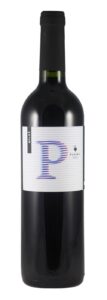
Longevity is synonymous with the wines of Frano Miloš (MEE loash). Wine collectors are still enjoying his youthful ’94 Plavac Mali (PLAH-vatz Molly). This wine is typical of the Pelješac (PELL yeh shatz) peninsula and the Miloš house style of wine. It has a very pronounced aromatic profile of deep, dark fruit, minerals and dried herbs (sage). The wine is slow to open, but once it does, the patient wine lover is rewarded by deep, concentrated flavors, a distinctive note of black tea and a savory saltiness that is typical of these seaside vineyards.
Plavac Mali (‘little blue’ – see image below) reigns in Pelješac. The region is planted nearly exclusively to it. As the offspring of the ancient variety Crljenak Kaštelanski (curl-YEN-ick cash-tell-AHN-ski, also known as Zinfandel, a grape that originated in Croatia). The grape has the genetics to thrive in the intense heat of the Adriatic summer.
Driven more by perfection than profits, Frano works only with Plavac from his own vines. His wines clearly reflect both his aesthetic and the essence of their place.
The Winery
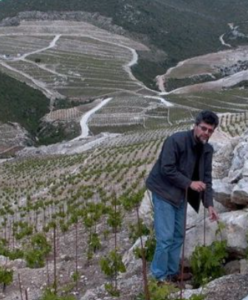
Frano Miloš in his seaside vineyard, Croatia
The first thing you notice when visiting Croatia’s Adriatic villages is the abundance of chalky stones and soils. They are everywhere you look – in sidewalks, walls, buildings, sea walls… and in their vineyards. And nowhere else in Europe will you find such a concentration of coastal vineyards. Near the idyllic oystering village of Mali Ston is the home where Frano’s family has lived and made wine for over 500 years. And a short drive from there is his seaside vineyard (right).
The vineyards’ proximity to the sea lends the wines a distinctive note the Croatians call ‘Friškina’ (frish KEEN nah), the “scent of the sea”. It’s this unique element of terroir that makes these rugged, full-bodied reds unexpectedly delicious when paired with certain seafoods. The Plavic Mali is sometimes even paired with oysters by the locals, though I have not tried that pairing and can’t recommend it personally. If you get a chance to do so, please let me know what you think!
And if you don’t choose to pair this wine with oysters, look instead to the classic pairings for Zinfandels – BBQ, braised meats, and other rich dishes, but expand that list to include lighter dishes as well. The wine can handle it.
6. Geyerhoff 2020 Zweigelt “StockWerk”, Kremstal. (Biodynamic) $27
The Wine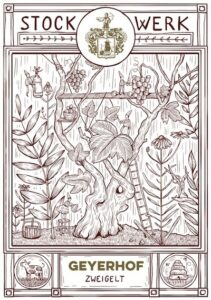
For our last wine of the month we return once again to Austria, this time for a wine from the Kremstal region Northwest of Vienna. This is one of the world’s best places for a number of Austria’s greatest grapes, including the Zweigelt (roughly, ‘tz-vhy-gelt’) used here. This is a bright, low alcohol (12.5% ABV), happy, Tyrolean bistro-style wine best served with loads of comfort food and accordion music. Or not, as you choose!
A word on the label – a close examination will reveal a detailed depiction of the Maier’s approach to sustainable vineyard management. You’ll find the farm animals who help to fertilize and weed by grazing, the bees that help create the diverse and healthy vineyard environment depicted on the label (right). I’m not sure what the vineyard elves are doing, but somehow they just seem to fit the fantasmagorical nature of it all.
The Winery
History books tell us Geyerhoff has been operating here since 1600, most recently by the Maier family (see below)
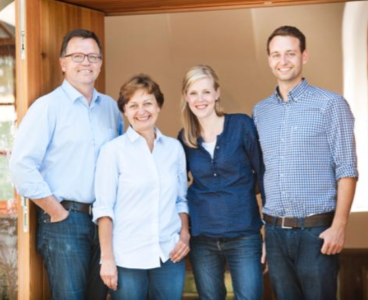
The Maier Family
Over 400 years in wine – that’s how long Ilse Maier’s family has lived in the hilltop village of Oberfucha. Her family history dates back to the 16th century when her family worked in agriculture and brickworks. In the 17th century, an arch duchess of Austria granted the property owner (whose name was Geyer) a concession to transport wine on the Danube to trade with Hungary. The ship on some of the Geyerhof wine labels is a reference to this part of the family history.
Geyerhof organically farms 48 acres of vineyards on the hills around the winery. This practice includes the promotion of beneficial plants and insects, the sowing of nitrogen-absorbing plants, use of compost and rock flour for plant nutrition, and abstaining from the use of any pesticides, insecticides, weed control substances and soluble mineral fertilizer.
Ilsa Maier joined her father in the business in 1986, after traveling to learn winemaking from various global producers. Today she is joined by her son, Josef who had to complete a similar educational path prior to joining the family business.


